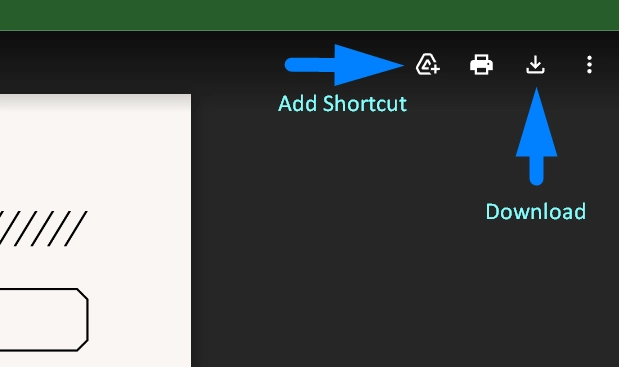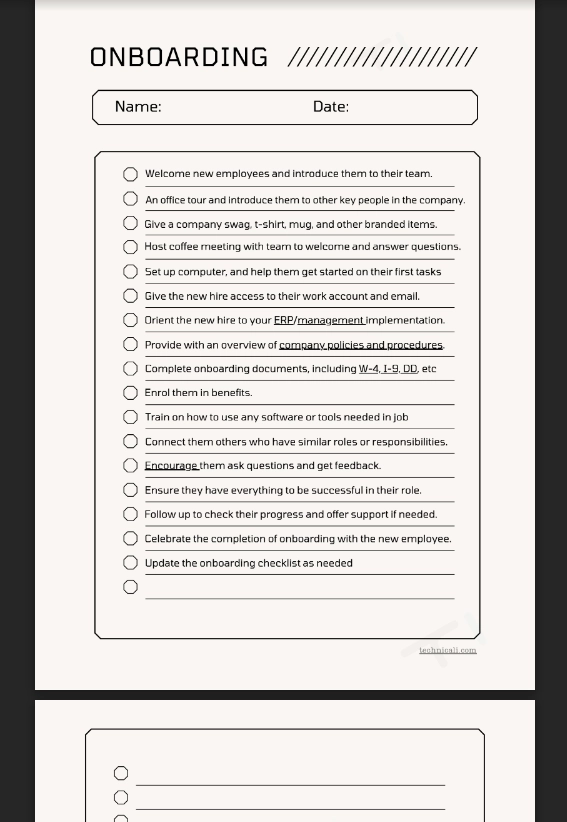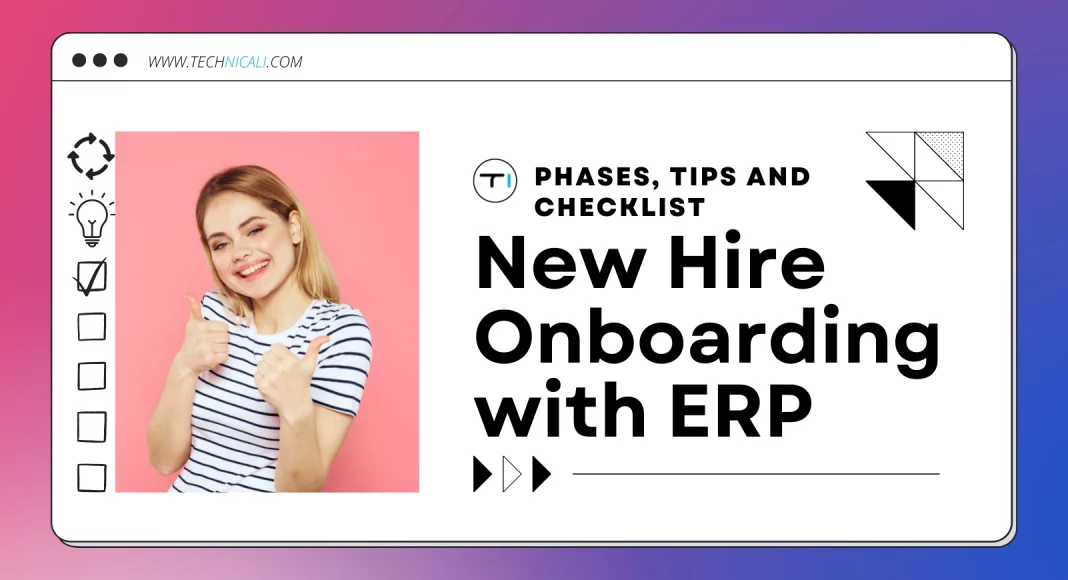You’re at your desk, staring at a computer screen that seems to have a will of its own. It’s been blinking for the last five minutes, but nothing happens no matter how many times you hit “return” or even mash the keyboard with your fists. You try to remember the last time you actually used this thing for anything other than Solitaire, and coming up blank, you give up and go find a supervisor to help.
2 minutes later
- > You: Hi! I think my computer is possessed! It just wouldn’t turn on, no matter what I tried.
- > Supervisor: Did you try turning it off and on again?
- > You: (blank stare)
- > Supervisor: Ok, let me show you how to do that.
This little vignette may be exaggerated (or maybe not), but Employee Onboarding can feel a lot like that for new hires.
Contents
What is Employee Onboarding, and How Do ERP systems help in it?

Onboarding is the process of integrating a new hire into the company and its role. It’s important to ensure that your new employees are properly trained on company procedures, software, and culture to be productive members of the team. Employee onboarding can be a long and complicated process, but it’s essential to get it right in order to ensure a smooth transition for the new employee.
One of the biggest challenges with employee onboarding is ensuring the new hire has all the information they need to do their job effectively. This often includes training on company software and procedures and learning about the company culture and how things work within the organisation. A new system of ERP can be a valuable tool for helping with employee onboarding.
ERP systems can help automate many of the tasks involved in employee onboarding and are missed by human error. This can include creating and managing user accounts, automating HR processes such as salary calculation and benefits management, and providing access to training materials and other resources. ERP systems can also help track employee progress through the onboarding process, providing managers with real-time updates on how new employees are doing.
Employee Satisfaction and Engagement are key factors in a company’s success. Those Employees who have a positive experience during their onboarding period are more likely to be satisfied with their job and more engaged in their work. ERP systems can play a key role in creating a positive onboarding experience by automating many administrative tasks, making it easier for new employees to get up to speed quickly.
Though it can look like a daunting task, I will break it down into phases and provide you with tips and a checklist with the help of an ERP system in your business processes to ensure you can make a successful Employee Onboarding experience.
What are the 4 Phases of Employee Onboarding

Now, Let’s explore the Employee Onboarding process in more detail.
Employee Onboarding can be broken down into four distinct phases:
Phase 1 is Pre-Onboarding / Initial Contact

As a manager or business owner, it is important to understand the first phase of new hire onboarding, also called pre-onboarding. This is the time from when a candidate accepts your offer and continues until their first day of joining. During this time, it is crucial to keep employees updated on organisational developments and manage them properly. This will help them feel more excited about their decision to join your organisation.
During the pre-onboarding phase, help employees complete all the necessary paperwork. Make sure to give them ample time as they may be finishing up with exit tasks at their previous organisation. If they are relocating, check if they need help finding housing or settling in. You can also introduce them to other new hires so that they can start building relationships even before their first day. Keep in touch with them regularly and update them on organisational changes and developments so they feel comfortable and confident joining your company.
Phase 2 is Welcoming all the new hires

Phase 2 of the employee onboarding process is welcoming new hires and orienting them to the organisation. This phase should last less than a week, with the first day being kept simple. During orientation, help new hires understand the organisation’s culture and how work practices are aligned with it. Discuss topics like time off, attendance, medical insurance, and payroll policies. Give them a clear picture of your organisation before they begin their work.
For example, at Technicali, we orient new hires with our cultural values, such as “Consider the public interest” and our philosophy around work-life balance. We also discuss our expectations around attendance and performance so that new hires clearly understand what is expected of them from the start.
Phase 3 is to have Role-specific User Training

Onboarding is not a one-time event but rather a series of phases that new employees go through in order to become fully integrated into the company. The third onboarding phase is role-specific user training, which helps employees learn the specific skills and knowledge they need to do their jobs. This phase can be customised to fit your company’s needs, and it may include online courses, on-the-job training, or both.
A good way to conduct role-specific training is to create modules in your ERP Learning Management System that employees can complete at their own pace. This will allow new hires to learn more about their roles in a relaxed setting without feeling overwhelmed.
Role-specific training is an important part of onboarding because it helps employees develop the skills they need to be successful in their jobs. It also sends the message that the company cares about its development and is committed to helping them grow professionally.
Phase 4 is to Let the Employee Shine

Once your new employee has completed the onboarding process, it’s important to continue providing them with support and resources to help them succeed in their new role. One way to do this is by setting clear expectations for them and helping them visualise what success, quality, and productivity look like. You should also conduct a performance review after a month or quarter to recognise their efforts so far and help them improve their performance.
Some tips and tricks for Employee Onboarding with ERP:

- Onboarding should be personalised: A warm, personalised greeting is the first step in making a good first impression. Sending new employees a card or personalised email lets them know they are valued and appreciated.
- Mentors can ease the transition: Having a mentor assigned to new employees can help with questions and provide support for professional growth. This mentor should be available on a day-to-day basis during the first few weeks or months on the job.
- Workspace should be ready and waiting: Make sure computers and other technology are set up and ready to go before the employee’s first day. This will help reduce stress and allow them to focus on getting up to speed on their new job duties.
- Company swag is a great way to show pride: Ordering some company swag and having it ready for new employees is a fun way to show them that they are part of the team. It also helps create brand recognition early on.
- Schedule regular check-ins: Regular check-ins with new employees during their first few weeks on the job. This will help ensure that they are getting acclimated well and have the resources they need to succeed.
- Onboarding should be efficient: Using ERP software can help organise and streamline the onboarding process, making it more efficient for everyone involved. This software can automate many of the tasks associated with onboarding, such as creating employee files, tracking training progress, and more.
- Provide clear expectations from day one: Setting clear expectations from day one will help reduce confusion and make the adjustment process smoother for new employees. Outline what is expected of them regarding work duties, hours, and company culture.
- Give them time to adjust: New employees need time to adjust to their new surroundings, co-workers, and job duties. Don’t expect them to be 100% productive immediately; instead, give them room to gradually grow into their role.
- Encourage socialisation: Help new employees get to know their co-workers by organising social events or breakfasts/lunches so they can chat informally outside work hours. This will encourage team bonding and help people get comfortable working together.
- Encourage new employees to ask questions and get help when needed: Asking questions is a normal part of the learning process, so encourage new employees to do so. And, if they need help, be sure to provide it. No one expects them to know everything right away; that’s what onboarding is for!
- Celebrate their accomplishments: Thank new employees for their hard work by celebrating any accomplishments they make during their onboarding period. This could mean sending a congratulatory email or giving out rewards such as gift cards or extra vacation days.
Employee Onboarding Checklist of Managers and Human Resources:
You can create your own checklist or use ours and edit it to better suit your needs.
- ✓ Welcome new employees and introduce them to their team.
- ✓ Give the new employee a tour of the office and introduce them to other key people in the company.
- ✓ Give the new employee a package of company swag, including a t-shirt, mug, and other branded items.
- ✓ Host a new employee coffee meeting with the team to welcome them and answer any questions they have.
- ✓ Set up the new employee’s computers, and help them get started on their first tasks.
- ✓ Give the new hire access to their work account and email.
- ✓ Orient the new hire to your Management/ERP implementation.
- ✓ Provide the new employee with an overview of company policies and procedures.
- ✓ Have the new hire complete onboarding payroll documents, including W-4, I-9, direct deposit form, etc
- ✓ Help the new employee enrol in benefits and complete all required paperwork.
- ✓ Train the new employee on how to use any software or tools they will need for their job.
- ✓ Connect the new employee with other employees who have similar roles or responsibilities.
- ✓ Encourage the new employee to ask questions and get feedback from their team members.
- ✓ Make sure the new employee has everything they need to be successful in their role.
- ✓ Follow up with the new employee regularly to check their progress and offer support when needed.
- ✓ Celebrate the successful completion of onboarding with the new employee
- ✓ Update the onboarding checklist as needed to reflect changes in company policy or procedure or changes in the new employee’s role.
Download This Checklist
Ah! I went ahead to our HR and got the company’s employee onboarding checklist, and added an extra black checklist for you to edit.
Just click Add Shortcut to drive, Print Or Download Directly.

No, I won’t be asking for you to signup for our newsletter: Employee Onboarding Checklist.pdf

Conclusion
Employee onboarding is a critical process for any organisation that relies on an ERP system. By following simple tips and phases, managers can ensure that their employees are properly trained on the system’s functionality and ability to use it effectively.
New ideas and onboarding processes can be quickly adopted when everyone is on the same page. Error-prone manual tasks are less likely to occur when there is a set process and checklist that everyone follows. Employee experience will improve when they feel like they are part of the team from day one, and this will improve their job satisfaction even if they are nomads working remotely.



